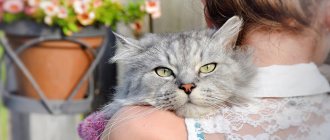What is the reason for the strained relationship?
Zoologists say that cats are not afraid of dogs, but avoid unnecessary contact. Dogs crave companionship. Cats, on the contrary, walk on their own, they require personal space, and they do not like it when someone violates it.
A dog may approach a cat out of curiosity, but the first meeting is unlikely to end in friendship. Murka will either run away or try to scratch the poor dog. If the cat runs, it will provoke the dog to play chase; if it starts to hiss and scratch, it will cause a defensive reaction, which will lead to fear or aggression.
After the first unsuccessful attempt at acquaintance, a cat and a dog may never become friends. Therefore, it is important to conduct the first meeting of pets correctly and avoid mistakes.
Treat animals equally
Divide your attention equally between both animals. The “old” inhabitant of the house needs your attention now more than ever. It is important that the arrival of a new resident is not associated with the loss of his privileges and position. Be careful not to neglect affection or reduce communication time in favor of the new family member. From now on, your attention should be divided into two parts.
It is necessary to ensure that both four-legged animals are treated with equal attention and love by all family members.
How to make friends between an adult cat and a dog
If the cat and dog are already adults, then making them friends can be much more difficult. Conduct the first meeting under strict supervision. It is better to put a muzzle on the dog or put the cat in a carrier. Then let them sniff each other.
It will most likely take a lot of time for the pets to get used to each other. A cat must have its own place in the house where it can feel safe. Meetings of animals at first should take place under your supervision. Joint walks especially bring pets together. Therefore, you can buy a harness for the cat and walk it with the dog. Outside the home, pets bond much faster.
If the cat shows aggression towards the dog
Most often, a cat's aggression towards a dog is associated with fear. What to do in this case?
- There is no need to punish the cat - this will only make the situation worse.
- Prevent situations in which the cat becomes aggressive (for example, consider how to properly distribute the territory so that the cat has safe, easy access to important resources and does not become cornered).
- Develop positive associations in your cat with the presence of the dog.
- If aggression occurs in the same places, it is worth “separating traffic flows” - for example, equipping a second tier for the cat in this particular place.
- Do not place the cat's bed where it is convenient for her to reach the dog with her paw - for example, near the aisle.
Everything is equally
Remember that a cat and a dog are animals with different characters and habits, so be thoughtful about keeping them together. Don't let the process of introducing pets take its course. Take matters into your own hands. Pay more attention to the animals, come up with different games in which both pets can participate. Never allow jealousy between your pets. Treat each one the same.
It is possible to make friends between a cat and a dog. This depends not only on the age and character of the pets, but also on the owner himself. Two pets in the house will require twice as much responsibility from you. If you are ready for this, then go ahead. You will succeed.
We hope that our tips will help you, and your cat and dog will become true friends.
If we bring a kitten into a house where an adult dog lives
As a rule, kittens, if they have not had negative experiences with dogs, are open to new acquaintances. And if the dog does not show aggression, the introduction can go smoothly. How to introduce a kitten to an adult dog?
- Bring the carrier with the kitten into the house and let the dog sniff it. Watch her reaction.
- Prepare a separate room for the kitten, where everything you need will be (tray, bowls, houses, scratching post, etc.) and release the kitten from the carrier there.
- Restrict your dog's access to the kitten's room.
- Never leave animals unattended so that the dog does not harm the kitten.
- Be careful that the kitten does not interfere with the dog when it is eating.
- Don't deprive your dog of attention. It is important that she does not feel discomfort from the arrival of a new tenant.
Ideal age
The easiest option for such cohabitation is pets of the same age. A kitten and a puppy growing up together will easily bond and become playmates. In this case, only one problem arises - the cat gets used to the absence of a threat from the dog. If the pet goes out for a walk on its own, it will not consider street dogs as a threat, which can end sadly.
Adult dog and kitten
An adult dog most often treats a kitten with friendliness. But excessive enthusiasm can scare the baby. To introduce pets without harm to the cat’s psyche, you should pay attention to a number of points:
- Animals must get used to each other's smell. To do this, for the first days it is better to keep them in different rooms, arranging a meeting for a while every day. Before a new resident arrives, you can give the dog something with the baby’s scent so that his appearance is not regarded as a threat.
- If the pet is very old or angry, special cat-scented pheromones should be used a few weeks before the kitten arrives. This way you can reduce the level of stress and, accordingly, anger.
- Dogs are jealous of their food, so food intake areas should be separated. In the future, the dog should always be fed first.
- Everyone should have their own corner. If the owner does not create conditions for rest and does not designate zones, the animals will figure it out on their own, which will worsen the relationship between them.
Adult cat and puppy
Puppies are easy-going by nature and aggression will not cause them any special psychological trauma, which cannot be said about physical ones.
The owner should limit the time the pets communicate, because even if the cat normally accepts the appearance of the baby in the house, he will still quickly get tired of noisy games and want to retire.
If animals have separate places for resting and eating, then acquaintance and further life will go smoothly.
Adult cat and dog
It is difficult to breed adult animals, but it is possible. This will take a very long time. The first meeting should take place under the full control of the person, since a dog that is not accustomed to living with a cat may regard it as prey or an object for play. Therefore, the dog must be muzzled and on a leash.
You should not let the dog get close, otherwise the cat will decide that he is being attacked and will begin to defend himself.
Every day you need to bring your pets together for a couple of minutes, monitoring their communication and possible manifestations of hostility.
What to do if your dog shows predatory aggression towards your cat
Predatory aggression is a dangerous thing: in this case, the dog can kill the cat. Therefore, it is extremely important to keep both animals safe. What can the owner do in this case?
- Above all, ensure safety. Don't allow your dog and cat to communicate unless you can control the communication.
- Allow the dog to watch the cat in a safe environment. The dog must be on a leash and muzzle, and it is better if there is a barrier between it and the cat (for example, a children's fence).
- Choose a distance at which the dog can look at the cat without lunging at it. If the dog cannot control itself, increase the distance.
- Praise your dog when he turns away from the cat.
- Reduce the distance very gradually.
- Start walking around the room. Vary the distance until you understand how far the dog can pass the cat without reacting. Reinforce this behavior and gradually reduce the distance.
- Allow a muzzled dog to sniff the cat, but only if the dog is calm.
- Hold or leash the dog and allow the cat to roam around the room. Reinforce your dog's calm behavior.
- If the dog reacts calmly to the cat every time, you can let him go and let them be in the room together in your presence.
- Be sure to monitor the behavior and body language of both animals, notice the slightest signs of excitement and stop communicating. Don't let negative experiences form.
Keep in mind that this type of aggression in a dog can take a very long time (sometimes years), so you will have to be patient.
Photo: commons.wikimedia.org
Mr. Cat recommends: tips for first meeting
Even before meeting, pets should be taught to adequately perceive representatives of another species. So, when walking, you need to scold them for barking towards cats or reward them for being friendly. In the future, the success of reconciling pets will depend on following the following tips:
- It is necessary to teach your pet the “Near” and “Sit” commands as early as possible, otherwise it will be difficult to control him.
- Cat's nails should be trimmed regularly.
- You cannot physically punish your pets.
- At the first signs of friendship between pets, you should not rush to arrange for them to live together. Animals left alone can quarrel and fight.
- When choosing a puppy in a shelter, it is important to find out from the workers which of the wards reacts calmer to cats.
- The most aggressive dogs towards cats are hunting dogs. Owners of such breeds should think carefully before making such a serious decision.
Cooperative games
A kitten and a puppy in the same apartment will run and play together, which means there is a high probability that they may accidentally harm each other. To prevent this from happening, it is important to monitor the length of the animals’ claws and trim them in time.
Games of small pets are usually a competition during which they learn to communicate and show their speed and dexterity. If you see that one of your pets has gone too far, bites hard or attacks, then you should intervene. However, you should never single out one pet and belittle another. Both should be punished for dangerous games. The leader of the pack should be the owner, and not any of the pets.
Rules for keeping in one room
The first and main law of such a community is the equal distribution of love and attention to both pets, so that thoughts of jealousy do not arise. In addition, each of them must have their own place for rest and food. Pets must understand that there is only one leader, and that is the owner. There are examples when people allowed one to punish the other, and the hostility between them did not stop. There must be one punishing hand.
In this case, it is important to understand that physical punishment must be avoided: the animal will remember the pain from the punishment and will associate it with its neighbor, directing all the anger and resentment towards him.
Feeding
First of all, the eldest is fed. Eating areas and bowls should be kept away from each other. If there is not much space in the apartment, you can leave the cat's bowl on the windowsill. From the very first days, pets must understand that stealing from a neighbor’s bowl is followed by punishment.
We recommend reading the article about who is better, a cat or a dog. There you will find a table with scientific facts, as well as a vote.
Common Mistakes
Inexperienced owners often do not know what to do in a given situation, which leads to the following mistakes:
- Poor nutrition: if everyone eats at the same time and nearby, then someone will inevitably try to steal food from someone else’s plate.
- Uncontrolled first meeting: some let the cat and dog communicate freely, not thinking that this could develop into a fight.
- Lack of separate resting places: cats are introverts by nature. Long communication will infuriate the pet and can lead to aggression. It is advisable to give the cat its place on a hill.
- Playing off animals: they will remember a fight that happens once for the rest of their stay, so clashes should not be allowed.
Sociability of dogs
As they say, a dog is man's best friend, which is fully justified by the quick attachment of dogs to their owners. Socialized dogs constantly need company.
- On a subconscious level, they strive to gain approval from the owner and can even set self-restraints in order to please and receive the coveted praise.
- There are often cases when a dog provides selfless help to a person, for example, when a child is drowning in a pond.
- The animal's instincts are triggered, and it immediately strives to help.
Therefore, dogs are trainable and quickly learn certain behavior patterns.
Cat and dog in the same house: how to make friends with pets
“Like a cat and a dog” or “friends forever”? This article will help you learn how to make friends with your pets.
There are people who are incorrigible cat lovers, and there are equally incorrigible dog lovers. And between these two groups of animal lovers, disputes often arise about which of the pets is better to have, which of the two pets is kinder, smarter, more affectionate, etc. Such disputes can already be classified as eternal.
And there are people who do not participate in such discussions for the simple reason that they cannot classify themselves as either a dog person or a cat person: they belong to both.
It is about the third type of people, or more precisely about their pets, that we will talk today.
If your dog or cat suddenly begins to behave aggressively
It would seem that peace and harmony reigned in the relationship between the dog and the cat, and then suddenly (out of the blue, as the owners say) one of the pets began to behave aggressively towards the other. What to do in this case? It depends on the reason for this behavior.
- Rule out the disease. Perhaps sudden irritability is a sign of illness, so you should contact your veterinarian.
- Analyze what preceded the manifestation of aggression. Perhaps one of the animals recently visited the veterinary clinic and “brought” a foreign smell. In this case, it is better to separate the pets until the “smell of the pack” returns, and allow interaction only under supervision.
- There may have been redirected aggression. For example, the dog got overexcited, and the cat got “under the hot paw” (or vice versa). In this case, you will have to go through the introduction scheme again to show the pets that they are safe with each other and develop positive associations from communication.
Main stumbling blocks
Fight for the owner's attention
Many have heard the phrase “The cat walks on its own.” I also diligently believed in this truth: my domestic cat is very affectionate, never rebels when trying to stroke or cuddle her, but she herself rarely seeks human attention, preferring to mind her own business. More precisely, she had this manner of behavior exactly until the moment when the second four-legged pet, the Pekingese, appeared in our house.
This is where a fierce struggle for the attention of all family members began: a competition called “Who can run to the door faster and meet the owners”; if they stroked or picked up one person, aggression on the part of the other immediately began.
Sometimes the situation can take more drastic turns: the cat, seeing that the dog is being taken for a walk, with its desperate meows will urgently demand that it be taken with them too.
Those who are planning to have a cat and a dog in the same house should remember how jealous animals are - almost like little children of the same age. Promise yourself to try to give the same amount of attention to both pets - this will prevent hostility between them.
If you have a cat at home, then you know how they eat: even if they have a full bowl of food, but no appetite, they will not eat against their will, but will leave it for later and will return to it throughout the day. Dogs have the exact opposite attitude towards food: they will eat everything in the bowl and ask for more.
Milles Away/Shutterstock.com
Coexisting in the same space with a dog, the cat will have to rebuild its gourmet habits: returning to the bowl during the day will not have the desired result, since the dog, having eaten its food, will also grab the cat’s portion.
Cat breeds that easily get along with dogs
These furry friends have a “dog-like” character, but at the same time remain real representatives of the cat family, affectionate, playful, sociable, curious and friendly to other animals.
- Abyssinian (long-haired version of “Abyssinian” - Somali) is the noblest and oldest breed that shows amazing patience with any animal on its territory.
- American Curl - will accept any dog, it is important that in the process of play it does not damage the delicate cartilages on the Curl's folded ears.
- Anatolian, Angora and Turkish Van - all three breeds have a common distant ancestor and similar character traits. Soft and unobtrusive, having become accustomed to being close to a dog, they will even show maternal care towards it.
- The Burmese Shorthair (Burma) is a creature that “recognized the Buddha.” They are affectionately attached to all family members, including dogs.
- Burmese (Burma) - calm and friendly, never seeks conflicts, avoids acute situations, is delicate and unobtrusive.
- Bobtails (Karelian, Kuril, Thai) are truly paladins of the cat world, capable of not only being friends with dogs, but also physically supporting them in a fight with an outside offender.
- The Devon Rex is amazingly friendly to everyone who lives next to him, affectionate, affectionate, talkative, sociable... No wonder he bears the title of “dog in a cat’s skin.”
- The Don Sphynx, as well as the Canadian and Peterbald , lack aggression and need protection and close communication. Having made friends with a shaggy pet, they will try to stay close to him, but will never demand increased attention, irritating their barking friend.
- Maine Coon - aggressive giants are simply not allowed for further breeding, so all representatives of the breed are genetically not inclined to discord, be it a person, another cat, a parrot or a dog.
- Manx (Mani) - they rarely enter into conflicts, they are very tolerant of children and dogs, even if they have to endure inconvenience from such neighbors.
- Ragdoll is an angelic character! In addition, he absolutely cannot stand loneliness. In order not to be left alone with a heavy heart, I am ready to make friends with a dog of any breed and size.
- Siberian - well-developed intuition and self-confidence. He will always be able to “agree” with a representative of the canine family.
- Singapura (Singapura) is small and timid, seeking protection and patronage. Will become a gentle friend to a dog with a noble character.
- The Tonkinese cat (Tonkinese) is playful and friendly, always in the center and always needs an “audience”. An excellent companion for an active, gentle dog of any size who loves games and pranks.
- The Chartreuse is a breed that has seen everything over its centuries-old history, so it can survive its proximity to any animal without loss.
- The Aegean is intelligent, patient, socialized to humans and other domestic animals from birth. If the dog does not offend her, then long-term friendships will begin quickly and firmly.
- Javanese (Mandarin) - very attached to the owner, to whom he can forgive everything in the world. If there is a dog next to the owner, Yavanez will forgive him even this, just to be closer to the object of his adoration.
Having found out which cats will agree to share shelter with a “foul-smelling” dog, it is worth looking at which dogs the cats get along with, so as not to be disappointed later.











